They say… 
Best beer and travel writing award 2015, 2011 -- British Guild of Beer Writers Awards
Accredited Beer Sommelier
Writer of "Probably the best book about beer in London" - Londonist
"A necessity if you're a beer geek travelling to London town" - Beer Advocate
"A joy to read" - Roger Protz
"Very authoritative" - Tim Webb.
"One of the top beer writers in the UK" - Mark Dredge.
"A beer guru" - Popbitch.

|
 Taking beer’s temperature: warm or cool? The piece below was first published in Beers of the World magazine issue 13, July 2007, and was my first proper feature piece to appear in a ‘newsstand’ title. It’s subsequently been reprinted with my permission in a couple of other places. Although I’d probably write it slightly differently today, and choose some different examples, the advice it gives remains sound.
The British, as everyone knows, drink warm beer. Or more accurately, they prefer their traditional ale at cellar temperature, rather than chilled. Though most Brits in truth now drink cold lager like everyone else, the fact that a sizeable minority continues to enjoy less refrigerated booze is heart warming, so to speak, in a commercial world where the thermometer is heading downwards.
Most people appreciate that different wines are best served at different temperatures – serving claret in an ice bucket or mulling your Muscadet is not the best way to impress at dinner parties. But when it comes to beer, whether it’s a well-aged Westvleteren Abt or Tesco Value Lager, there’s a tendency to simply bung it in the fridge with the rest of them.
In Belgium they take a little more care – specialist beer pubs often boast several fridges set to different temperatures. While in Britain you might get a grudging “Serve Cool” on the label, in Belgium the temperature is usually specified in precise degrees, though not always reliably – sadly some Belgian brewers have also succumbed to chiller mania and increasingly recommend inappropriately cold temperatures.
So what difference does temperature really make? Apply energy by heating something up and its molecules start buzzing around busily, bumping into other molecules and occasionally escaping. As a substance cools down, its molecules move more sluggishly, and are less likely to interact with their neighbours. When those molecules are what give a beer its odour and flavour, the warmer they are, the more energy they’ll have to bounce around the taste and smell receptors in your nose and mouth.
The body itself is a warm place and its systems work best at warmer temperatures: cold substances in the mouth literally numb the senses, not to mention their challenge to our digestive system. On the other hand, drinking something cold helps cool us down when hot, so can be experienced as pleasantly refreshing. The marketers of chilled beer trade on the appeal of this with endless images of condensation-jewelled bottles.
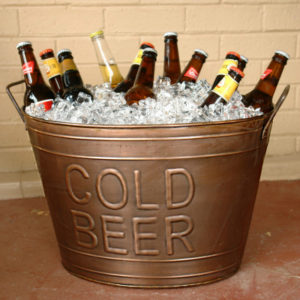 The visual appeal of the chiller tub may not suit every beer. though it’s likely advisable for most of those in this photo. Pic: homewetbar.com. Behind such images is an assumption that beer’s only function is to make us feel refreshed despite the dehydrating effects of alcohol, and the truth is that most beers marketed in this way are good for little else. Where a beer has little native aroma and flavour, serving it at a warmer temperature will simply expose its emptiness. Chilling it, particularly to 4°C or below, makes it limitations less evident by neutralising the tastebuds. More cynical brewers have long taken advantage of this by using excessive refrigeration to disguise cheap and nasty beer.
This is not to say that all good beers should be served uniformly warm. British and Belgian ales are warm fermented — unsurprisingly their chemistry is most active at warmer temperatures and their recipes evolved to taste good when drunk from a pub cellar in a cool climate. Traditional German and Czech lager styles originate from more southerly climates where they were brewed in deep, icy caves – the resulting smoother flavours work better at lower temperatures, maintaining enough hop aroma to cut through.
Avoid the habit of keeping beer indiscriminately in the fridge for days or weeks and both your taste buds and the yeast cells in a bottle conditioned beer will reward you. Anything half decent is best kept in a dark cupboard at a relatively constant temperature and only put in the fridge, if at all, for a controlled length of time before it’s consumed.
However it’s tricky to achieve precise temperatures at home. Wine thermometers designed to be left in a bottle neck as the contents gradually warms or cools are less useful with beer, which starts to go flat as soon as it’s opened. So try experimenting by keeping beer in the fridge for a set length of time and checking the results – your own taste is at least as good as a thermometer here.
Fridge temperatures vary according to how much other stuff is in them, when it was put there, and how often the door is opened and closed – which is likely to be often if it’s also the place you keep tonight’s snacks and tomorrow’s breakfast. Constant fluctuations in temperature aren’t good, and putting beer in the freezer for a few minutes to cool it quickly is definitely bad. Remember fridge temperatures get cooler as you move deeper inside – the back of my fridge can sometimes freeze an ice pop, but the milk rack inside the door stands in well for a cool pub cellar.
Room temperature seems straightforward – but in these days of global warming and central heating it’s warmer than it used to be. It’s best suited to big, strong and complex beers like barley wines, imperial stouts and high gravity abbey ales. Arguably such beers are best when a couple of degrees short of contemporary tastes in home heating, at around 17°C, an hour or so in a milder part of the fridge.
European pale and brown ales and stronger German beers like bocks are best at that good old cellar temperature of 12-14°C, perhaps a couple of hours in the fridge door. American derivatives of these styles tend to be brewed with slightly cooler temperatures in mind, around 10°C. Golden and summer ale, Altbier and lambic also work well at this level, and some may prefer to cool session strength stout and porter for a little longer than bitter and pale ale.
Below this things get controversial. Some sources – including certain beer labels – suggest chilling wheat beers, Duvel-style strong golden ales, Kölsch and quality blond lager to a genuinely cold 6°C or below. In my view many of these beers only reveal their true delights at slightly warmer temperatures (see below). It’s worth experimenting here to find your own personal preference.
Whatever you do, experimenting with temperature will add variety to your drinking – and will hopefully convince you that, whatever the million dollar marketing campaigns might say, as far as good beer is concerned, it’s often cool to be warm.
Chilled examples
 Budweiser Budvar, Three B’s Shuttle Ale and Robinson’s Old Tom face the temperature test. In researching this article I conducted a home tasting of three very different beers at three different temperatures.
Chilling Budweiser Budvar to 5°C does it no favours, neutralising the aroma and more interesting flavour elements on the palate, and allowing too much emphasis on bitter hop resins. At a cellar-cooled 12°C there’s more aroma, more delicate hop flavours and juicier malt. Room temperature reveals some surprising whiskyish, spirity notes – the quality of the beer holds up but it’s a less intense experience.
Three B’s Shuttle Ale, an excellent microbrewed bottle conditioned bitter from Lancashire, has a good malty, orangey aroma when served cold, but numbing the mouth again lends undue weight to hop bitterness. It’s much better balanced at cellar temperature, revealing more fruit and roast notes. When chambré, the hop aroma is intense and earthy, but the thick marmalade notes get just a bit cloying.
Classic dark barley wine Robinson Old Tom is a challenge when chilled: the combined numbing effect of cold and alcohol is like a mouthful of dentists’ novocaine! The powerful dry cocoa finish still shows through, but the flavour development is better at cellar temperature, with tannins and cake notes more evident. The beer is still richer and more luscious at room temperature, with fruit and smooth burry hops better integrated.
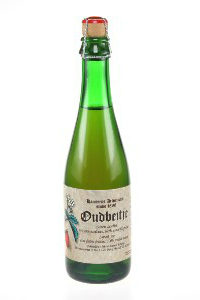 Hanssens Oudbeitje ABV: 6%
Origin: Dworp (Beersel), Vlaams-Brabant, Flanders
First published: 5 February 2001
Another review from the archive written for the pioneering Oxford Bottled Beer Database (OBBD). I’ve left it uncorrected — so please read it in that historical spirit.
Hanssens, established in 1871, remains — just — as the last of the old-established geuzestekerijen and this , arguably their most famous beer, is still in production. As a stekerij, the company doesn’t brew its own lambics but sources inoculated wort from Boon, Girardin and Lindemans, which it ferments and matures in its own wooden barrels, and in the case of Oudbeitje matures on whole strawberries.
Hanssens, of Dworp, near the classic lambic village of Beersel in the Brussels area, is a proud old house of négociants and geuzestekerijen or gueuze blenders. This is their unusual attempt at a fruit lambic, not with the traditional sour cherries or raspberries but with fresh strawberries. The name is a pun on the Dutch word for strawberries, aardbeien, and literally means something like ‘old varnish’.
I’m not a great fan of fruit beers but this one is something special, and extremely subtly done. It’s a lively beer, with enough pressure to send the champagne cork with which it was sealed flying across the room on opening, which suggests it is based on the gueuze and achieves its carbonation from the vigorous secondary fermentation.
The smell is musty and hoppy initially, then slightly sharp, and the beer is an intriguing straw in colour with reddish hints, resembling nothing so much as Lucozade. The palate is initially sweet, and then the characteristic rhubarb sourness of the company’s gueuze reveals itself, with hints of wood and citric fruit.
Then, a delightfully delicate and elusive strawberry scent wafts through the mouth, with the tartness as well as the scent of the berries apparent. The strawberry hints persist into the throat, eventually overtaken by late, crisp hop.
What really makes this beer is its subtlety: Hanssens have taken what is already an excellent product and woven in a little extra magic, rather than hiding the noble austerity of lambic behind cloying swathes of fruit syrup as some of the more commercial fruit beer producers in the area have done. Very good indeed.
 Caledonian Burns Ale ABV: 4.7%
Origin: Edinburgh, Scotland
Website: www.caledonianbeer.com
First published: 5 February 2001
Another review from the archive written for the pioneering Oxford Bottled Beer Database (OBBD). I’ve left it uncorrected — so please read it in that historical spirit. Caledonian is no longer “proudly independent”: Scottish Courage became involved in 2004 and by 2008 the business was wholly owned by Heineken. Burns Ale remained as a seasonal for a few years after this review but hasn’t appeared since the ScotCo takeover.
I’m not one for celebrations but Caledonian brews are always worth trying, and these were piled high at Sainsbury’s supermarket in anticipation of Burns Night, so I succumbed and bought one to mark the occassion.
This historic Edinburgh brewery uses the only direct fired open coppers left in Britain; it was formerly owned by now-defunct northeast England brewer Vaux but has been proudly independent since a management buyout in 1987 [but see above], developing a range of well-made ales based on traditional Scottish models but with a flair for innovation and a faintly caramelly house character from the brewing method.
Burns Ale, brewed annually for January release, was bottle conditioned when launched in 1999 but now, like
most of their bottled beers, it appears to be pasteurised: it’s a shame they don’t bottle condition more often. The connection between this beer and the poet after whom it was named is obscure, unless Burns had anything particularly to do with rye, since this distinctive grain is present in both pale and crystal malt forms; another point of interest about the recipe is that this is a ‘single varietal’ hop beer, only hopped with English Goldings.
The beer is golden, with a sweetly malty, strawberry sherbert and slightly vinegary nose. It has a full malt palate, with a crisp ‘Shreddies’ character and some aromatic rye in the background. The hops are well-balanced, bringing raisins and orange to a dry finish, with more hop bitterness than many Scottish beers.
Overall, the beer is fine, but despite the claims to malty depth on the label, it’s rather lacking in complexity and development. Nice way to raise a toast to ‘Rabbie’, though.
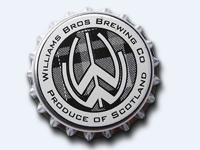 Williams Brothers Brewery ABV: 4.4%
Origin: Alloa, Clackmannanshire, Scotland
Website: www.williamsbrosbrew.com
First published: 5 February 2001
Another review from the archive written for the pioneering Oxford Bottled Beer Database (OBBD). I’ve left it uncorrected — so please read it in that historical spirit.
At the time of writing, the beer was brewed at the Forth Brewery in Alloa, a microbrewery set up by employees of the historic Maclay brewery when this closed in 1994. Williams Brothers eventually bought out Forth in 2004 and relocated it to another site in Alloa, where Kelpie is still brewed today, though not bottle conditioned.
This innovative Scottish micro’s quest for unusual brewing ingredients proceeds from heather and gooseberries to seaweed in this product which, judging by its packaging, is brewed with the US market in mind. The brewery is now in Strathaven, and most of its bottled product (including this beer, presumably) is brewed in Alloa, Clackmannanshire. It was formerly based in Argyll, however, and it’s the Argyll coast that apparently provides the fresh bladder wrack seaweed added to the mash.
According to the label, barley hereabouts was formerly grown on fields fertilised with seaweed and the beer is attempting to mimic the flavour this lent the resulting brews. Otherwise the beer is a dark brown-black, Schwarzbier-like brew made with organically grown pale and chocolate malts, not bottle conditioned.
It has an unusual nose, with malt, chocolate, cream and, indeed, a faint salt and iodine tang, though this is hardly “the aroma of a fresh sea breeze” the label promises. More bracing is its very fine mousse, yielding in the mouth a chocolatey but quite light malt character, drying but not over-bitter, and a pleasantly smooth texture. A certain saltiness does develop in the finish, with some restrained hops, and there is a late hint of sweet green leaves, rather like pak choy, but it’s no more maritime in flavour than Adnams.
As the beer settles it develops a surprisingly distinctive milk chocolate note. It’s pleasant and interesting but rather short on finish, and surprisingly mild-mannered when you consider that only those expecting to be provoked with strong flavours might be tempted to crack open a bottle.
 Van Steenberge Augustijn Grand Cru ABV: 9%
Origin: Ertvelde, Oost-Vlaanderen, Flanders
Website: www.vansteenberge.com
First published: 5 February 2001
Another review from the archive written for the pioneering Oxford Bottled Beer Database (OBBD). I’ve left it uncorrected — so please read it in that historical spirit.
Augustijn Grand Cru is still available from Van Steenberge, also known as Bios, a brewery I’ve since had the opportunity to visit. In certain territories including the UK it’s marketed by AB InBev under the name St Stefanus Grand Cru, though the brewery itself remains independent.
The brewery, in Ertvelde, East Flanders, is known for sweet-sour brown ales like Duchesse de Bourgogne [whoops — I meant Bios Vlaamse Bourgogne, now easier to find in the US than Belgium, under the name Monks Café Flemish Sour Red Ale], but this example from their generically-named abbey beer range is blond and tastily dry.
It’s a very delicate straw-coloured bottle conditioned beer that exudes an initially citric, later honeyed aroma full of the promise of hops, along with a malty smell that’s almost like soy sauce. In the mouth it has a lively bead and is bone dry but honey-textured on the tongue. The taste is complex: very herby, with some tangy, sherberty mango and passion fruit, intense hoppy dryness, and soft, phenolic and almost wheaty notes that finish with a flash of alcohol in a lingering, slightly soapy finish.
The name might suggest something in the style of Hoegaarden’s Grand Cru but this isn’t thick, rich or peachy enough and, despite the aromatic flavours, is not spiced. Instead the model seems to be the herbaceous dryness of Orval, and while the beer falls considerably short of this Trappist masterpiece, it’s still an impressive and stimulating ride.
 Allgäuer Altenmünster Brauer Bier urig würzig ABV: 5.3%
Origin: Altenmünster, Bayern, Germany
Website: www.altenmuenster-brauerbier.de
First published: 5 February 2001
Another review from the archive written for the pioneering Oxford Bottled Beer Database (OBBD). I’ve left it uncorrected — so please read it in that historical spirit, especially as in this case I guessed horribly wrong about the beer’s origins.
Altenmünster has nothing to do with Münster in Nordrein-Westfalen: it’s in Schwaben (Swabia) in Bavaria. The beer is a lager, not an Alt or Kölsch style. The beer is still around in its stoppered bottle, though in 2002 the original Sailerbräu brewery was taken over and closed, and the brand is now based at Allgäuer in Kempten, now part of the Oetker/Radeberger group. The strength has been reduced to 4.9%.
I picked this up from Bottles in east London, knowing little about it but perhaps attracted by the chunky Grolsch-style swing-top bottle. I then tried to find background references to it, but ended up having to go to the company’s website. It’s a bit of an oddity – it’s broadly in a Kölsch or Altbier style, a golden beer brewed with ale yeast but lagered, though it’s not from the classic region. Perhaps as the name suggests it’s from close to Münster where Pinkus Müller brews an Alt.
Whatever its origin, it’s an excellent brew. It’s a beautiful pale blond, pouring with a fine, lively mousse and some head. The aroma is rich, honeyed and malty with a flowery, citrus-peel character that suggests Styrian hops. The taste is lovely and clean, slightly honeyed with melon notes and a developing, exquisitely delicate flowery hoppiness.
The hops take on a lime-like character in the pleasant finish, receding beneath the crisp malt for a while, then returning for a late burst of citric bitterness way back in the throat. Well worth looking out for.
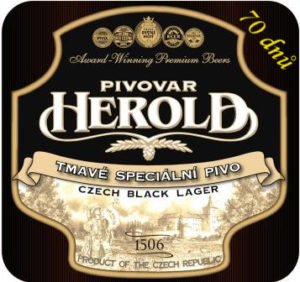 Herold Tmavé speciální pivo ABV: 5.3%
Origin: Březnice, Středočeský kraj, Czech Republic
Website: www.pivovar-herold.cz
First published: 5 February 2001
Another review from the archive written for the pioneering Oxford Bottled Beer Database (OBBD). I’ve left it uncorrected — so please read it in that historical spirit.
Herold, likely one of the world’s oldest breweries, has thankfully survived the upheavals in the Czech industry in recent years. It spent a period under US ownership but has been Czech-owned again since 2008. This beer has gone by several names including Bohemian Black Lager and Černý ležák (‘Black lager’).
The brewery, in a castle at Březnice, south of Prague, used to be a state-owned brewing research institute, and is known for re-introducing wheat beer to the Czech beer scene. This beer is in the old style of black lager which, as Schwarzbier, is also found in the eastern part of Germany.
The label boasts a recipe of four malts, Saaz/Žatec hops and a 70-day lagering period in the castle cellars, plus a gold medal which, if my extremely rudimentary grasp of Czech is holding up, was awarded at the Czech Beer Competition in 2000.
The beer is actually not quite black but a deep ruby, pouring lively with a nice head and a smooth, refreshing and malty-hoppy aroma, with yeasty notes despite no evidence of bottle conditioning. The initial palate is full-on bitter chocolate, with good malt character and some vanilla creaminess, complimented by peachy notes on the swallow: the overall smoothness speaks of conscientious lagering.
Then the Saaz shows itself with a marked, bracing hop kick in the finish. If memory serves, this beer has the edge in terms of character over a better-known Czech entrant in the style, Black Regent, so that gold medal may well have been deserved.
 Spaten Franziskaner Hefe-Weissbier Dunkel ABV: 5%
Origin: München, Bayern, Germany
Website: www.franziskaner-weissbier.de
First published: 5 February 2001
Another review from the archive written for the pioneering Oxford Bottled Beer Database (OBBD). I’ve left it uncorrected — so please read it in that historical spirit.
Franziskaner Dunkel is a classic brand that’s still very much with us, although owned by AB InBev and its predecessors since 2003. The Franziskaner brand’s roots go back to 1363 and the foundation of a secular brewery adjacent to (but not part of) a Franciscan monastery in Munich. It’s been under the same ownership as the celebrated Spaten brewery since 1861 and used to identify that brewery’s wheat beer since 1964.
The logic of German beer labels dictates the apparent contradiction in the name of this dark ‘white’ beer from one of Munich’s biggest brewing names. In Germany major brewers still keep to certain standards, and this standard-issue dark wheat beer in the Bavarian style is an impressive and very good quality brew.
It’s a bottle-conditioned beer that pours with a beautiful thick head, revealing a rich reddish colour beneath and an inviting scent of bananas and cloves wafting from the top. It has a full, malty taste with delicate hop notes (hops are restrained in this style, and they’re present here only in the form of extract, as the ingredients list confirms).
The combination of fruity, slightly acidic notes and a beautifully soft texture gives the impression of peaches and cream, and the dark malts offer chocolate flavours as the taste develops. A taste of cloves emerges in the dry, biscuity, cracker-like finish to round off a very drinkable example of a classic style. No wonder the rotund Franciscan on the label looks so contented.
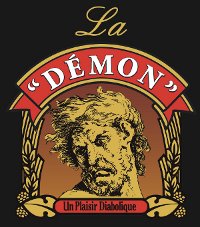 Gayant La Démon ABV: 12%
Origin: Douai, Nord, France
First published: 5 February 2001
Another review from the archive written for the pioneering Oxford Bottled Beer Database (OBBD). I’ve left it uncorrected — so please read it in that historical spirit.
Founded by a merger of several breweries in the Douai area in 1919, Gayant (named after the giants of Flemish folklore) has been under the same ownership as the Saint-Omer brewery since 2010. Though La Démon is still strong stuff, its claim to being the strongest pale beer in the world is long lost.
Spotting the origin of this beer from the label is not straightforward: it claims to follow a recipe from the Boxer Brewery in Lausanne, Switzerland (does this establishment still brew?), but it’s actually made by Gayant, a small brewery in Douai, French Flanders, that’s also known for its apricottish bière de garde La Goudale. The label still claims that the beer is the strongest pale beer in the world, and though this claim has in fact been substantially challenged in recent years, it’s still best to avoid swigging back pints of the stuff.
The colour is very blond and crystal clear (it’s not bottle conditioned), with a light malty aroma. It doesn’t taste anything like its strength, having a clean malt palate with warming citric hints and a developing grapefruity dryness. Only a late, oily whiff of spirit-like alcohol on the swallow gives the game away, but blink and you’ll miss it in the onset of the dry slightly herby finish.
Not unpleasant, but to be honest, there’s very little to it, given the gravity and compared to some other ultra-strong brews like Bush. Since there are so many much weaker beers with much more interesting flavours that can be enjoyed in greater quantities, this is probably one for headbangers only.
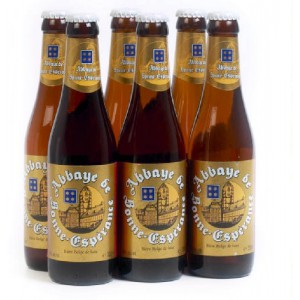 Abbaye de Bonne Espérance Ambrée ABV: 7.8%
Origin: Quenast, Brabant-Wallonie, Wallonia
Website: www.bonneesperance.be/fr/la-biere
First published: 5 February 2001
Another review from the archive written for the pioneering Oxford Bottled Beer Database (OBBD). I’ve left it uncorrected — so please read it in that historical spirit.
This beer is now an officially recognised Belgian abbey beer bearing the Erkend Belgisch Abdijbier logo, though it’s no longer brewed by Lefebvre. In early 2015 it was moved to Brasserie La Binchoise in Binche, Hainaut. The abbey website makes no reference to honey being using, but does say the wort is boiled in a direct-fired copper and the beer is dry hopped and bottle conditioned.
I sampled this soon after this Brabant brewery’s dark honey beer, Barbãr Winter Bok, and though the latter has hints of Styrian hops and honeysuckle, the scent of this abbey beer is overwhelming when first poured: not only honeysuckle but real, country honey. You can almost see the bits of honeycomb in the jar.
The beer is a lightish amber, and pours cloudy, though the label has no reference to bottle conditioning. As the head diminishes more drying, herbal hop notes come through, and the beer proves notably well-hopped in the mouth, with orange, lychee, a honeyed yeastiness and a slightly cloying alcoholic taste that persists into the cheek-puckering, tart and mildly soapy finish. The conclusion is firmly in the direction of dry, bitter hops.
This is one of those beers that smells great and is very flavoursome but doesn’t turn out to be as satisfying as it should be, perhaps because the flavours could be better integrated.
|
Cask  This pioneering new book explains what makes cask beer so special, and explores its past, present and future. Order now from CAMRA Books. Read more here. This pioneering new book explains what makes cask beer so special, and explores its past, present and future. Order now from CAMRA Books. Read more here.
London’s Best Beer  The fully updated 3rd edition of my essential award-winning guide to London’s vibrant beer scene is available now from CAMRA Books. Read more here. The fully updated 3rd edition of my essential award-winning guide to London’s vibrant beer scene is available now from CAMRA Books. Read more here.
|
















